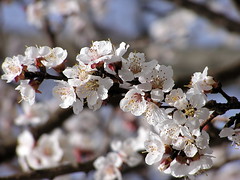[Notice the byline? Please welcome Elizabeth West to Photodoto. Elizabeth is a writer by profession and a collector of historic images of women. She’s also recently jumped into the digital camera market with both feet and currently shoots a Canon EOS 30d, Olympus 740 UZ, and a Canon Digital Elph (which she won in a Photodoto photography contest!). You can learn more about her writing and collection at her websites: Eduwrite at Cornerhost and EWestPhotos. — John]
Depth of field is a concept dear to the hearts of many photographers. Briefly, it means the depth of the pictured area that appears to be in focus. People describe this area as being shallow or deep. Some may refer to it as narrow or wide. The words don’t matter, but the concept does.
Here’s an example that clarifies the concept: suppose a photograph shoots a train moving towards you. In a picture with shallow depth of field (DOF), only the front of the locomotive will be in focus. In a picture with a deep DOF, the locomotive and several cars will be in focus. (To learn more about the concept of DOF, see “Clearing up Depth of Field,” April 29, 2006.)
Why should you care about depth of field? It is a useful tool in several ways. First, it helps you make your point photographically. It nudges viewers to notice what you want them to notice. Do you want your picture to emphasize a forest or the trees in it? Depth of field can make this clear.
Suppose you are a flower lover. You see a beautiful fruit tree in bloom. You photograph it several times, changing the depth of field each time.
One picture is taken close in with a shallow DOF. It draws attention to the beauty of a few blossoms. The rest are out of focus. The other picture has a deep DOF. Many blossoms are in focus. The second picture draws attention to the explosion of white blossoms. Each image makes a different point.
Now look at a very different picture. What did you first notice? Most people say“the eyes.”There’s a good reason for this.
The human eye is somewhat lazy. Rather than try to focus a blur, it quickly moves to an area of sharp focus. That’s why your eyes move so quickly to the little boy in the picture. Although a piece of furniture stands in front of him and the room continues beyond him, your eyes quickly lock on his because of the shallow depth of field. The out-of-focus foreground and background provide only a context for the smiling eyes.
Depth of field can be extremely shallow. On a flower, just the tips of the petals might be in focus, while the center of the blossom blurs. A photographer might choose this to emphasize the fragility of flower petals. However, in another picture, such as a landscape, a photographer might want a very deep depth of field to capture the details of a huge vista.
Depth of field can also help you in another way. DOF can disguise a multitude of messes. Use it to effectively eliminate messy or distracting objects in an image. Perhaps you want to show just one face in a crowd or one line on a page. Maybe you want to focus on a lovely crystal glass and ignore whatever is behind it.
The actual background in this picture is a sliding glass door that overlooks a deck, a lawn, a birdbath, and leafy trees. That scene is pretty but busy, and its sheer busyness distracts the eye from the crystal glass and its contents. The background was easily removed by using a shallow depth of field, which blurred the details into oblivion.
In digital photography, many factors affect depth of field, including your distance from the subject, the focal length of your lens, and the aperture, or size of the opening, of your lens. People with sophisticated cameras usually control DOF by adjusting their lens aperture. A rule of thumb is that smaller apertures usually create greater depth of field. (Unfortunately, the aperture is described with numbers, and larger numbers refer to smaller apertures, which seems counterintuitive to many people. One mnemonic device is to remember that“small numbers equal shallow DOF.)
People with point-and-shoot cameras usually affect depth of field by selecting various modes. They do not need to struggle with manual settings unless they want to. Portrait mode or macro mode usually results in a shallow DOF; landscape mode usually results in a larger DOF.
To get comfortable with depth of field, try this exercise. Try placing a big solid object, such as a box, 8-10 feet in front of a busy background. Photograph it at least twice, once using shallow and once using a deep DOF. Chances are, when you see the results, you will know which is which even if you don’t keep track.


In one of these pictures, the DOF is so shallow that the bear’s foot is not even in focus. In the other picture, it is so deep that you can spot the reflections below the bear and the details behind it. Although the subject of both pictures is the same, the effect is different.













0 comments